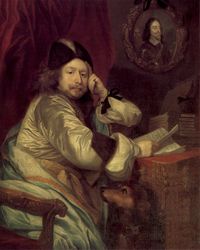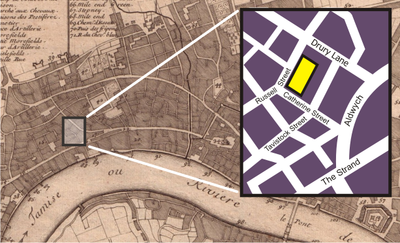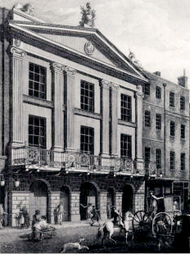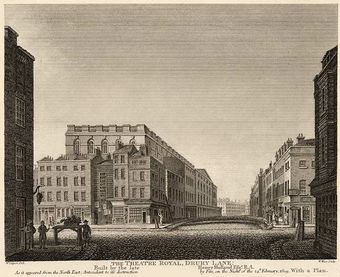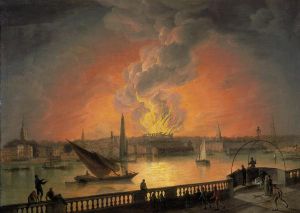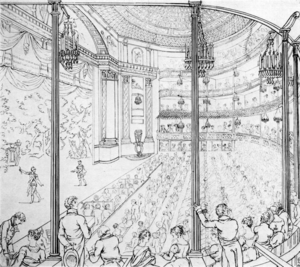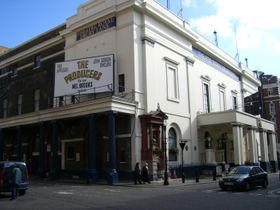Theatre Royal, Drury Lane
2007 Schools Wikipedia Selection. Related subjects: Architecture; Theatre
The Theatre Royal, Drury Lane is a theatre in the Covent Garden district of London, facing Catherine Street (earlier named Bridges or Brydges Street) and backing onto Drury Lane. The building standing today is the most recent in a line of four theatres at the same location dating back to 1663. For its first two centuries, Drury Lane could "reasonably have claimed to be London's leading theatre" and thus one of the most important theatres in the English-speaking world. Through most of that time, it was one of a small handful of patent theatres that were granted monopoly rights to the production of "legitimate" drama in London.
The first theatre on the location was built on behest of Thomas Killigrew in the early years of the English Restoration. Actors appearing at this "Theatre Royal in Bridges Street" included Nell Gwyn and Charles Hart. It was destroyed by fire in 1672. Killigrew built a larger theatre in the same spot, designed by Christopher Wren; now called the "Theatre Royal in Drury Lane", it opened in 1674. This building would last nearly 120 years, under leadership including Colley Cibber, David Garrick, and Richard Brinsley Sheridan. In 1791, under Sheridan's management, the building was demolished to make way for a larger theatre, which opened in 1794. This enormous new Drury Lane survived just 15 years, burning down in 1809. The building that stands today opened in 1812. It has been home to actors as diverse as Shakespearean Edmund Kean, comedian Dan Leno, and musical composer and performer Ivor Novello. Today, the theatre is owned by composer Andrew Lloyd Weber and generally stages popular musical theatre.
First theatre: 1663
After the decade-long Puritan Interregnum, which had seen the banning of pastimes regarded as frivolous, including theatre, the English monarchy was restored to the throne with the return of Charles II in 1660. Soon after, Charles issued Letters Patent to two parties licensing the formation of new acting companies. One of these went to Thomas Killigrew, whose company would become known as the King's Company, and who would build a new theatre in Drury Lane. The Letters Patent also granted the two companies a shared monopoly on the public performance of legitimate drama in London; this monopoly would be challenged in the 18th century by new venues and by a certain slipperiness in the definition of "legitimate drama", but remained legally in place until 1843. The new playhouse, architect unknown, opened on 7 May 1663 and was known from the placement of the entrance as the "Theatre Royal in Bridges Street". It went by other names as well, including the "King's Playhouse". The building was a three-tiered wooden structure, 112 feet long and 59 feet wide; it could hold an audience of 700. Set well back from the broader streets, the theatre was accessed by narrow passages between surrounding buildings.
The King himself was a not infrequent attendee of the theatre's productions, as was Samuel Pepys, whose private diaries provide much of what we know of London theatre-going in the 1660s. The day after the Theatre Royal opened, Pepys attended a performance of Francis Beaumont and John Fletcher's The Humorous Lieutenant. He has this to say in his diary:
The house is made with extraordinary good contrivance, and yet hath some faults, as the narrowness of the passages in and out of the Pitt, and the distance from the stage to the boxes, which I am confident cannot hear; but for all other things it is well, only, above all, the musique being below, and most of it sounding under the very stage, there is no hearing of the bases at all, nor very well of the trebles, which sure must be mended.
Performances usually began at 3 p.m. to take advantage of the daylight: the main floor for the audience, the pit, had no roof in order to let in the light. A glazed dome was built over the opening, but judging from another one of Pepys' diary entries, the dome was not entirely effective at keeping out the elements: he and his wife were forced to leave the theatre to take refuge from a hail storm.
Green baize cloth covered the benches in the pit and served to decorate the boxes, additionally ornamented with gold-tooled leather, and even the stage itself. The backless green benches in the pit were in a semicircular arrangement facing the stage, according to a May 1663 letter from one Monsieur de Maonconys: "All benches of the pit, where people of rank also sit, are shaped in a semi-circle, each row higher than the next." The three galleries formed a semicircle around the floor seats; both the first and second galleries were divided up into boxes.
The King's Company was forced with some reluctance to commission the technically advanced and expensive Theatre Royal playhouse by the success of the rival Duke's Company, which was drawing fascinated crowds with their "moveable" or "changeable" scenery and visually gorgeous productions at Lincoln's Inn Fields. Imitating the innovations at Lincoln's Inn Fields, the Theatre Royal also featured moveable scenery with wings or shutters that could be smoothly changed between or even within acts. When not in use, the shutters rested out of sight behind the sides of the proscenium arch, which also served as a visual frame for the on-stage happenings. The picture-frame-like separation between audience and performance was a new phenomenon in English theatre, though it had been found on the Continent earlier. However, theatre design in London remained ambivalent about the merits of the "picture-box" stage, and for many decades to come, London theatres including Drury Lane would have large forestages protruding beyond the arch, oftentimes including the thrust stages found in the Elizabethan theatres. The players could still step forward and bridge the distance between performer and audience, and more than that, it was not unusual for audience members to mount the stage itself.
Killigrew's investment in the new playhouse put the two companies on a level as far as technical resources were concerned, but the offerings at the Theatre Royal nevertheless continued to be dominated by actor-driven "talk" drama, contrasting with William Davenant's baroque spectacles and operas at Lincoln's Inn Fields. Internal power structures were the main reason for this difference: while Davenant skilfully commanded a docile young troupe, Killigrew's authority over his veteran actors was far from absolute. Experienced actors Michael Mohun (who Pepys called "the best actor in the world") and Charles Hart held out for shares and good contracts in the King's Company, and they despised baroque spectacle. Such a division of power between the patentee Killigrew and his chief actors led to frequent conflicts. These were bad for the Theatre Royal as a business venture; but on the other hand, its strong and confident actors and their insistence on dialogue and literary quality over ornament and visual effects were good for the rebirth of English drama. It was mostly at struggling Theatre Royal, rather than at efficiently run Lincoln's Inn Fields, that the plays were acted that are classics today. This applies especially to the new form Restoration comedy, dominated in the 1660s by William Wycherley and the Theatre Royal's house dramatist John Dryden. Actors such as Hart and Charles II's mistress Nell Gwyn developed and refined the famous scenes of repartee, banter, and flirtation in Dryden's and Wycherley's comedies, and these actors made a creative contribution almost, John Harrington Smith has claimed, on a level with that of the dramatists. Another factor in the direction the drama took at this time was the appearance of actresses for the first time on the British stage. Their presence encouraged playwrights to focus on outspoken female characters, daring love scenes, and provocative breeches roles.
The Great Plague of London struck in the summer of 1665, and the Theatre Royal, along with all other public entertainment, was shut down by order of the Lord Mayor and Aldermen of the City of London on 5 June. It remained closed for 18 months, until the autumn of 1666, during which time it received at least a little interior renovation, including widening of the stage. Although the theatre survived the Great Fire of London, which raged through the city in September 1666, it was to burn down six years later on 25 January 1672.
Second theatre: 1674
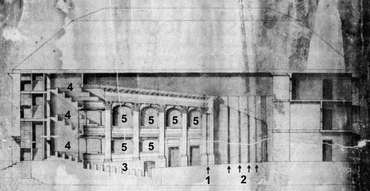
The King's Company never recovered financially from the loss of the theatre in Bridges Street. The competitive pressure from the Duke's Company forced them to keep investing, however, and construction work began immediately on an even larger and more luxurious theatre which housed an audience of 2,000. This was the Theatre Royal in Drury Lane, designed by Christopher Wren, which opened on 26 March 1674. The new house was financed through selling more company shares, which meant that yet more money had now to be made from ticket sales.
The second theatre complex was composed of the large auditorium by Wren and, by the time of Garrick's management, comprised ten connected structures. These buildings contained a warren of offices, practice rooms, storage space and dressing rooms used by the theatre management and performers, nearly seventy people total, as well as some fifty technical staff members. Additionally three rooms were provided for scripts, including a library for their storage, a separate room for copying actor's parts and a special library for the theatre's account books, ledger books and music scores. This jumble of rooms often made communication among various departments difficult, a problem that David Garrick would correct during his tenure as manager. The entire complex occupied 13,134 square feet bounded by Drury Lane (east), Brydges Street (west), Great Russell Street (north) and Little Russell Street (south).
Entering the theatre from Drury Lane, theatre-goers navigated narrow passages that lead under over-hanging apartments to entrances for the various lobbies; one for each of the three main sections of the theatre: the pit, gallery and boxes. The new theatre interior retained the green cloth of the first, but seems to have been built according to a more rectilinear plan. Henri Misson, a visitor from France, offers a description of the theatre in 1698:
The Pit is an Amphitheatre, fill'd with Benches without Backboards, and adorn'd and cover'd with green Cloth. Men of Quality, particularly the younger Sort, some Ladies of Reputation and Virtue, and abundance of Damsels that haunt for Prey, sit all together in this Place, Higgledy-piggledy, chatter, toy, play, hear, hear not. Farther up, against the Wall, under the first Gallery and just opposite to the Stage, rises another Amphitheatre, which is taken by persons of the best Quality, among whom are generally very few Men. The Galleries, whereof there are only two Rows, are fill'd with none but ordinary People, particularly the Upper one.
As Misson points out, the seating was divided by class and tickets were priced accordingly. Box seats, used by the nobility and wealthy gentry cost 5 shillings; the benches in the pit which often sat some gentry, but also critics and scholars, cost 3 shillings; tradesmen and professionals occupied the first gallery with seats costing 2 shillings while servants and other "ordinary people," as Misson refers to them occupied the 1 shilling seats of the upper gallery. Seats were not numbered and offered on a "first come first served" basis leading many members of the gentry to send servants to reserve seats well ahead of performances.
The image to the right shows a cross-section of a playhouse drawn by Wren, and is thought to be a plan for the 1674 Theatre Royal. The second Amphitheatre mentioned by Misson, in the rear, is the lower gallery.
All of these spectators had a clear view of the stage. The stage was 45 feet wide and 30 feet deep with a raked floor from the footlights to the back drop. The angle of the rake rose one inch for every 24 inches of horizontle stage, therefore an actor standing at the back of the stage was 15 inches above an actor at the footlights. The stage floor included grooves for wings and flats in addition to trap doors in the floor. The proscenium arch covered the stage equiptment above the stage that included a pair of girondels--large wheels holding many candles used to counteract the light from the footlights. Towards the latter part of the 18th century, doors were placed on either side of the stage and a series of small spikes traced the edge of the stage apron to prevent audiences from climbing onto the stage. At the very back of the stage, a large door was placed that opened to reveal Drury Lane.
An added difficulty for Killigrew and his sons Thomas and Charles was the political unrest of 1678–84 with the Popish Plot and the Exclusion crisis distracting potential audiences from things theatrical. This affected both the King's and the Duke's companies, but most of all the King's which had no profit margin to carry them through the lean years. In 1682 the companies merged, or rather, the King's was absorbed by the Duke's. Led at the time by Thomas Betterton, the United Company, as it was now called, chose Drury Lane as their production house, leaving the Duke's Company's theatre in Dorset Garden closed for a time. In 1688 Betterton was removed from managerial control by Alexander Davenant, son of William Davenant, the original patent holder for the Duke's Company. Davenant's management (with Charles Killigrew) proved brief and disastrous, and by 1693 he was fleeing to the Canary Islands in the wake of embezzlement charges. The Theatre Royal would find itself in the hands of lawyer Christopher Rich for the next 16 years.
Neither Davenant's nor Killigrew's sons were much better than crooks, and Rich attempted to recoup their depredations of the company's resources by cost-cutting tyranny, pitting actor against actor and slashing salaries. By 1695 the actors, including day-to-day manager and acting legend Thomas Betterton, were alienated and humiliated enough to walk out and set up a cooperative company of their own. Nine men and six women departed, all established professional performers, including such draws as tragedienne Elizabeth Barry and comedienne Anne Bracegirdle, leaving the United Company — henceforth known as the "Patent Company" — in "a very despicable condition", according to an anonymous contemporary pamphlet:
The disproportion was so great at parting, that it was almost impossible, in Drury Lane, to muster up a sufficient number to take in all the parts of any play; and of them so few were tolerable, that a play must of necessity be damned, that had not extraordinary favour from the audience. No fewer than sixteen (most of the old standing) went away; and with them the very beauty and vigour of the stage; they who were left being for the most part learners, boys and girls, a very unequal match for them that revolted.
A private letter from 19 November 1696 reported that Drury Lane "has no company at all, and unless a new play comes out on Saturday revives their reputation, they must break." The new play, Rich's last hope, is assumed to have been John Vanbrugh's The Relapse, and it turned out the success the company needed. Christopher Rich would continue as its head until 1709, when the patent in question was actually revoked amid a complex tangle of political machinations. A lawyer named William Collier was briefly given the right to mount productions in Drury Lane, but by 1710 the troupe was in the hands of the actors Colley Cibber, Robert Wilks, and Thomas Doggett — a triumvirate that would eventually find themselves sharply satirised in Alexander Pope's Dunciad. In 1713 Barton Booth replaced Doggett.

Cibber was the de facto leader of the triumvirate, and he led the theatre through a controversial but generally successful period until 1733, when he sold his controlling interest to John Highmore. It is likely that the sale was at a vastly inflated price and that Colley's goal was simply to get out of debts and make a profit (see Robert Lowe in his edition of Cibber's Apology). Members of the troupe at the time were most displeased; an actor's revolt was organised and executed; Charles Fleetwood came to control the theatre. Fleetwood's tenure was tumultuous; his abolition of the practice of allowing footmen free access to the upper gallery led to riots in 1737, and Fleetwood's gambling problems entangled the theatre in his own financial difficulties. It was during this period that actor Charles Macklin rose to fame, propelled by a singular performance as Shylock in an early 1741 production of The Merchant of Venice, in which he introduced a realistic, naturalistic style of acting, abandoning the artificial bombast typical to dramatic roles prior.
In 1747 Fleetwood's playhouse patent expired. The theatre and a patent renewal were purchased by actor David Garrick (who had trained under Macklin earlier) and partner James Lacy. Garrick served as manager and lead actor of the theatre until roughly 1766, and continued on in the management role for another ten years after that. He is remembered as one of the great stage actors and is especially associated with advancing the Shakespearean tradition in English theatre — during his time at Drury Lane, the company mounted at least 24 of Shakespeare's plays. Some of Shakespeare's surge in popularity during this period can be traced to the Licensing Act of 1737, which mandated governmental approval of any play before it could be performed and thereby created something of a vacuum of new material to perform. Garrick shared the stage with company including Peg Woffington, Susannah Cibber, Hannah Pritchard, Kitty Clive, Spranger Barry, Richard Yates and Ned Shuter. It was under Garrick's management that spectators were for the first time barred from the stage itself.
Garrick commissioned Robert Adam and his brother James to renovate the theatre's interior, which they did in 1775. Their additions included an ornate ceiling and a stucco facade facing Bridges Street. This facade was the first time any structure that might be considered part of the theatre proper actually abutted the street: the building, like the 1663 original, had been built in the centre of the block, hemmed in by other structures. The narrow passage from Bridges street to the theatre now became an interior hallway; some theatre office space also went up behind the new facade.
With a series of farewell performances, Garrick left the stage in 1776 and sold his shares in the theatre to the Irish playwright Richard Brinsley Sheridan. Sheridan and his partners would complete their purchase of Drury Lane two years later, and Sheridan would own it until 1809. Sheridan premiered his own comedy of manners The School for Scandal in 1777. Active management of the theatre was carried out by a number of parties during Sheridon's ownership, including himself, his father Thomas, and, from 1788 to 1796 and 1800 to 1802, the popular actor John Philip Kemble.
Third theatre: 1794
The theatre was in need of updating by the end of the 18th century and was demolished in 1791. A third theatre was designed by Henry Holland and opened on 12 March 1794. This was a cavernous theatre, accommodating more than 3,600 spectators. The motivation behind building on such a large scale? In the words of one owner:
I was aware of the very popular notion that our theatres ought to be very small; but it appeared to me that if that very popular notion should be suffered to proceed too far it would in every way deteriorate our dramatic performances depriving the proprietors of that revenue which is indispensable to defray the heavy expenses of such a concern.
New technology facilitated the expansion: iron columns replaced bulky wood, supporting five tiers of galleries. The stage was large, too: 83 feet wide and 92 feet deep. Holland, the architect, said it was "on a larger scale than any other theatre in Europe". Except for churches, it was the tallest building in London.
The "very popular notion that our theatres ought to be very small" proved hard to overcome, however. Various accounts from the period bemoan the mammoth size of the new theatre, longing for the "warm close observant seats of Old Drury", as one May 1794 theatre-goer put it. Actress Sarah Siddons, then part of the Drury Lane company, called it "a wilderness of a place" (and would leave Drury Lane along with her brother John Philip Kemble in 1803). Not only was any sense of intimacy and connection to the company on stage lost, but the very size of the theatre put a great deal of the audience at such a distance from the stage so as to make hearing a player's voice quite difficult. To compensate, the productions mounted in the new theatre tended more toward spectacle than the spoken word. An example of such a spectacle is a 1794 production that featured real water flowing down a rocky stream into a lake large enough on which to row a boat. This water issued from tanks in the attics above the house, which were installed — along with a much-touted iron safety curtain — as proof against fire.
Richard Sheridan continued as theatre owner during the entire lifetime of this third building. He had grown in stature as a statesman during this time, but troubled finances were to be his undoing. The 1794 rebuilding had cost double the original estimate of £80,000, and Sheridan bore the entirety of the debt. Productions were more expensive to mount in the larger structure, and increased audience revenues failed to make up the difference.
An assassination attempt against King George III took place at the theatre on 15 May 1800. James Hadfield fired two pistol shots from the pit toward the King, sitting in the royal box. The shots missed by inches, Hadfield was quickly subdued, and George, apparently unruffled, ordered the performance to continue.
On 24 February 1809, despite the previously mentioned fire safety precautions, the theatre burned down. Already on the shakiest financial ground, Sheridan was ruined entirely by the loss of the building. He turned to brewer Samuel Whitbread, an old friend, for help. Whitbread agreed to head a committee that would manage the company and oversee the rebuilding of the theatre, but asked Sheridan to withdraw from management himself, which he did entirely by 1811.
Modern theatre: 1812
The present Theatre Royal in Drury Lane, designed by Benjamin Wyatt on behalf of the committee led by Whitbread, opened on 10 October 1812 with a production of Hamlet featuring Robert Elliston in the title role. The new theatre made some concessions toward intimacy, seating 3,060 people, about 550 fewer than the earlier building. In 1820 the portico that still stands at the theatre's front entrance on Catherine Street was added, and in 1822, five years after gas lighting was installed, the interior underwent a significant remodelling. The colonnade running down the Russell Street side of the building was added in 1831.
Productions relying more on scenery and effects than on dialogue and acting remained commonplace in the new facility. The 1823 production of Cataract of the Ganges had a finale featuring a horseback escape up a flowing cataract "with fire raging all around". Effects for an 1829 production were produced by hydraulic apparatus that reportedly could discharge 39 tons of water.
There were those concerned that the theatre was failing in its role as one of the very few permitted to show legitimate drama. Management of the theatre after it reopened in 1813 fell to Samuel Arnold, overseen by an amateur board of directors and a subcommittee focusing on the theatre as a centre for national culture. ( Lord Byron was briefly on this subcommittee, from June 1815 until leaving England in April 1816.) Actor Edmund Kean was the on-stage highlight; like Macklin before him, he made his reputation as Shylock, premiering in the role in 1814. Kean would remain until 1820, but despite his popularity, the committee-led efforts to appeal to culture yet still turn a profit eventually proved a failure, and in 1819 the theatre and all its accompanying rights were leased to Robert Elliston.
Elliston was bankrupt and unable to renew his lease in 1826. An American, Stephen Price, followed (1826–30); then through most of the remainder of the 19th century, Drury lane passed quickly from one set of hands to another. Even well-remembered efforts like William Charles Macready's 1841–43 seasons were financial disasters. The theatrical monopoly first bestowed by Royal Letters Patent 183 years earlier was abolished by Parliament in 1843, but the patent had been largely toothless for decades and this had little immediate effect. The 19th-century run of financial and artistic failures at Drury Lane culminated with F. B. Chatterton's 1878 resignation; in his words, "Shakespeare spells ruin, and Byron bankruptcy." During the 19th century, Drury Lane staged ballet as well, with performers including Italy's Carlotta Grisi.
Productions relying on spectacle became even more the norm at Drury Lane in the later parts of the century, particularly under the managements of Augustus Harris (1879–96) and Arthur Collins (1896–1923). Examples include the successful 1909 The Whip, which featured not only a train crash complete with hissing steam, but also a horserace: twelve real horses jockeying on an on-stage treadmill. Harris instituted an annual pantomime in 1889; starring already well-known comedian Dan Leno, the performances were a major success. Earlier, Harris hosted the Carl Rosa Opera Company for many of their productions in the 1880s and early 1890s.
The last major interior renovation was in 1922, leaving a four-tiered theatre able to seat between 2,200 and 2,300 people. Composer and performer Ivor Novello, immensely popular in his time though little-remembered today, presented his musicals in Drury Lane from 1931 until the theatre was closed in 1939 because of World War II. During the war the theatre served as the headquarters for the Entertainments National Service Association; it sustained some minor bomb damage as well. The theatre reopened with Noel Coward's Pacific 1860 in 1946.
In the post-war years, a number of Rodgers and Hammerstein musicals made their London debuts in Drury Lane, including Oklahoma! (1946), South Pacific (1951) and The King and I (1953). American imports also included Lerner and Loewe's My Fair Lady, which began a five-year run in 1958. Comedy troupe Monty Python also performed one of their reunion shows here. Today, the theatre is part of the West End theatre scene, still generally staging popular musical productions. It is owned and managed by Really Useful Theatres, a division of Andrew Lloyd Weber's Really Useful Group. Long-running recent productions include 42nd Street (1984–89) and Miss Saigon (1989–99). It is currently showing a revival of Mel Brooks' musical The Producers, which is scheduled to close in January 2007, to be followed by a musical version of The Lord of the Rings.
Ghosts
Drury Lane has been called one of the world's most haunted theatres. The appearance of almost any one of the handful of ghosts that are said to frequent the theatre signals good luck for an actor or production. The most famous ghost is the "Man in Grey", who appears dressed as a nobleman of the late 18th century: powdered hair beneath a tricorne hat, a dress jacket and cloak or cape, riding boots and a sword. Legend says that the Man in Grey is the ghost of a knife-stabbed man whose skeletal remains were found within a walled-up side passage in 1848.
The ghosts of actor Charles Macklin and comedian Joe Grimaldi are supposed to haunt the theatre. Macklin appears backstage, wandering the corridor which now stands in the spot where, in 1735, he killed his fellow actor Thomas Hallam in an argument over a wig. ("Goddamn you for a blackguard, scrub, rascal!" he shouted, thrusting a cane into Hallam's face and piercing his left eye.) Joe Grimaldi is a helpful apparition, purportedly guiding nervous actors skilfully about the stage on more than one occasion.

